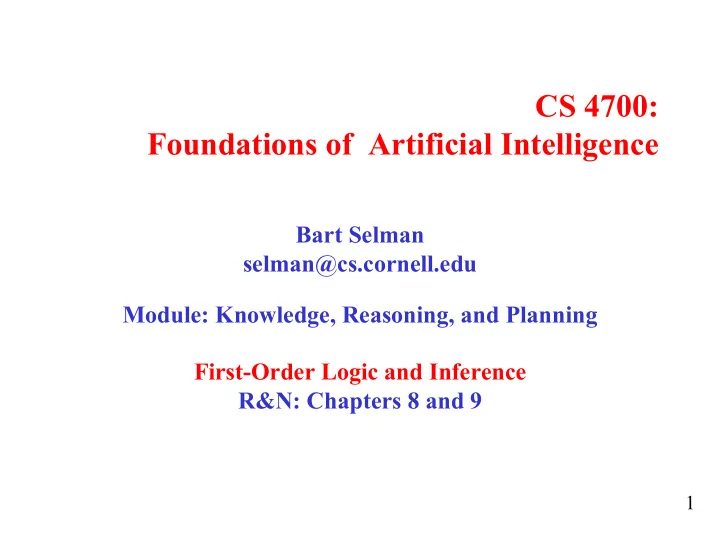

CS 4700: Foundations of Artificial Intelligence Bart Selman selman@cs.cornell.edu Module: Knowledge, Reasoning, and Planning First-Order Logic and Inference R&N: Chapters 8 and 9 1
2
3
4
5
6
7
8
9
10
11
12
13
14
15
16
17
18
Finite domains === “essentially propositional.” Also called: Propositional schema. 19
20
21
22
Also discussed earlier. Here some additional axiom details. R&N Section 10.4.2. 23
24
à situation Result(action, situation) à (unique outcome) 25
26
Again, as discussed in propositional case. 27
28
R&N 8.4.2. Further illustration of FOL formulation. 29
30
Always define first and carefully. 31
32
33
34
35
36
Aside: previously The same here but we want a bit more “detailed answer”. Inference will also give us variable bindings if existential query is entailed. 37
38
Done with prop. logic. Just check for syntax and FOL form. 39
40
41
See R&N p. 443 FOL formalizations can be challenging for “everyday” concepts. Probabilistic representations (extending prop. logic / FOL) can help! 42
Chapter 9 R&N. But for finite domains that are not too large, better to “ground to” propositional and use SAT solver. 43
44
45
46
47
Find the “right” substitution for a universal quantified variable. 48
49
Can substitute in because original clause universally quantified. 50
51
52
53
54
55
56
Natural language input. (From dog to more general.) (General statement.) The query YES! What “hidden” background knowledge is being used? 57
( ) Cats are animals. Not stated explicitly! This is an example of background Query: KB |== Kills(Curiosity, Tuna) ?? knowledge key to Natural Language Understanding. Executable semantic parsing. 58 Persi Liang, Stanford. NLU needs to resolve “ the cat” to Curiosity!
D is a “fake name” for the dog. Negation of query! 8. ¬ Kills(Curiosity, Tuna) Proof by contradiction Missing? for resolution. 59 Translation to clausal form automatic.
i.e. : Kills(Curiosity,Tuna) Warning: Non-standard notation!! 60
First-order resolution proof (more carefully) 9. ¬ Owns(x, D) ∨ AnimalLover(x) using S(x)/D 10. AnimalLover(Jack) using x/Jack 11. Animal (Tuna) using z/Tuna 61
11. Animal (Tuna) 12. ¬ AnimalLover(w) ∨ ¬ Kills(w, Tuna) using y/Tuna 10. AnimalLover(Jack) 13. ¬ Kills(Jack, Tuna) using w/Jack 14. Kills(Curiosity, Tuna) 15 lines; trivial with modern solvers. 8. ¬ Kills(Curiosity, Tuna) Can do 1+ billion lines! 15 ⧠ (contradiction reached) 62 So, KB |== Kills(Curiosity, Tuna)
So, we answered a natural language query using (1) Natural language parsing (almost there) (2) Background knowledge (much work remaining) (3) Reasoning (works fine now) We will see much progress in this kind of natural language question answering in next decade. Eg executable semantic parsing. 63 Persi Liang, Stanford.
64
65
66
67
68
Certain sets of first-order statements can overwhelm general resolution solvers, e.g. about infinite sets (natural numbers). Or, better yet, for finite domains, fall back to SAT solvers. 69
Concludes propositional and first-order logic for knowledge representation and reasoning. Next “Big Picture Slide” 70
AI Knowledge- Data- Inference Knowledge Triangle Intensive Computer Vision NLU Common Sense 20+yr GAP! Google’s Knowl. Graph Semantic Web Watson Verification Google Transl. Siri Object recognition Robbin’s Conj. 4-color thm. Sentiment analysis Google Search (IR) Deep Blue Speech understanding Reasoning/ Data Search Intensive Intensive 71
Recommend
More recommend